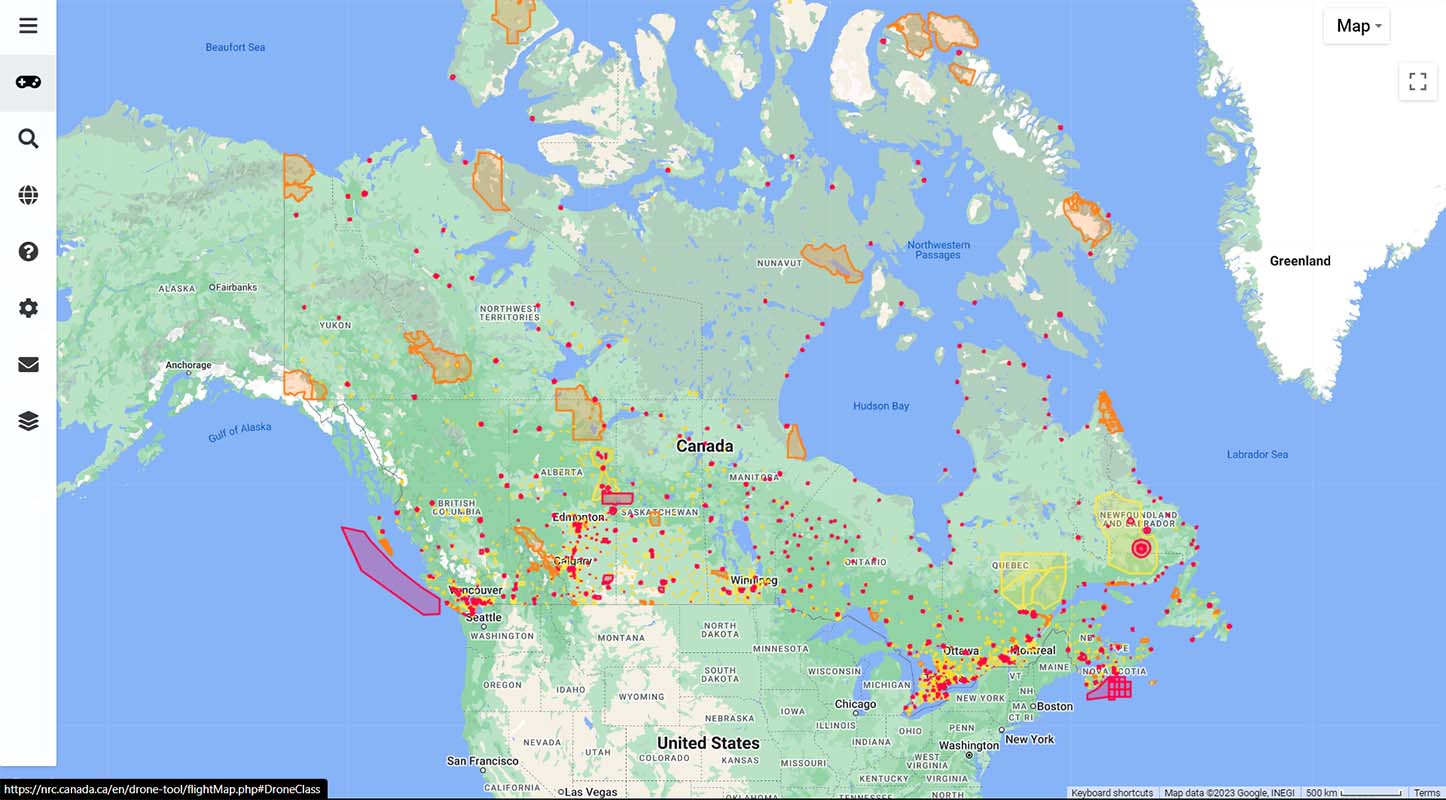Last edited on December 01 2023
Introduction
Drones are becoming more popular and accessible than ever before. Whether you want to use them for fun, photography, or business, drones can offer you a new perspective and a lot of enjoyment. However, flying a drone in Canada is not as simple as buying one and taking off. There are rules and regulations that you need to follow to ensure the safety and privacy of yourself and others. In this blog post, we will answer the question: “Can I fly my drone in Canada?” and give you some tips on how to do it legally and responsibly.
Drone Regulations in Canada
In Canada, drones are also known as remotely piloted aircraft systems (RPAS) or unmanned aerial vehicles (UAVs). Transport Canada is the federal department that oversees the drone regulations in Canada. According to Transport Canada, drone regulations do not differentiate between recreational and commercial use. This means that you need to follow the same rules whether you fly your drone for fun or for work.
Transport Canada has two drone certificates: basic and advanced. The certificate you need depends on where you want to fly your drone and how close you want to fly to other people. Here are the main differences between the two certificates:
- Basic certificate: You need a basic certificate if you want to fly your drone in uncontrolled airspace, which is the airspace where there is no air traffic control service. You also need to fly your drone more than 30 meters (100 feet) horizontally from bystanders, which are people who are not directly involved in your drone operation. You must be 14 years or older to get a basic certificate. Get your basic certificate: INSERT LINK
- Advanced certificate: You need an advanced certificate if you want to fly your drone in controlled airspace, which is the airspace where there is air traffic control service. You also need an advanced certificate if you want to fly your drone within 30 meters (100 feet) horizontally from bystanders, or over bystanders. You must be 16 years or older to get an advanced certificate. Get your advanced certificate: INSERT LINK
To get either certificate, you need to pass an online exam. You then need to register your drone with Transport Canada. You also need to mark your drone with its registration number before flying. The online exam for the basic certificate has 35 questions and the exam for the advanced certificate has 50 questions. The exams cover topics such as air law, navigation, meteorology, and drone operations. You need to score at least 65% to pass the basic exam and at least 80% to pass the advanced exam.
If you want to get an advanced certificate, you also need to pass a flight review, which is a practical test of your drone skills and knowledge. You need to find and book a flight reviewer who is authorized by Transport Canada to conduct the flight review. The flight review consists of two parts: a pre-flight briefing and a flight demonstration. You need to show that you can fly your drone safely and follow the rules and procedures.
If you are a foreign drone operator, you need to get a Special Flight Operations Certificate (SFOC) to fly your drone in Canada. An SFOC is a document that gives you permission to operate your drone outside the rules for basic or advanced operations. You need an SFOC for any purpose, whether it is recreational, work, or research. You also need a Canadian drone pilot certificate, either basic or advanced, depending on where and how you want to fly your drone. To apply for an SFOC, you need to submit an application to Transport Canada at least 30 working days before your planned flight. You also need to provide proof of meeting the knowledge requirements, such as a certificate from a drone school or a copy of your exam results. You can find more information about the SFOC application process and the requirements for foreign drone operators on Transport Canada's website or read our blog post on foreign operator requirements.
Airspace Restrictions for Drones in Canada
Even if you have a drone certificate, you still need to be aware of the airspace restrictions for drones in Canada. You cannot fly your drone anywhere you want without checking the airspace first. There are different types of airspace in Canada, such as controlled, uncontrolled, restricted, and prohibited. You need to know what type of airspace you are flying in and what rules apply to it.
Very generally, for basic operations in Canada you are not permitted to fly a drone within 3 nautical miles (5.6 km) of a certified airport or military aerodrome or within 1 nautical mile (1.9 km) of a heliport. If we only applied this definition to the airspace around Vancouver, for example, then you may think that over half of the city of Vancouver was flyable with a basic drone certificate, but that is not the case. In fact, in Vancouver there is only an incredibly small section of the city where you are allowed to fly with a basic certificate and the reason for this is something called a terminal control area.
A terminal control area is an area of airspace near larger airports where there is a high volume of traffic. In these areas the airspace is more restricted to reduce the amount of aircraft in the area, thereby making it easier and safer to control the traffic. You can find terminal control areas around all of Canada’s major airports and many of their secondary airports also. These areas often extend up to 6 nautical miles away from an airport, but not always. They also sometimes have unusual shapes due to other airports and terrain.
Luckily there is an interactive map called the Drone Site Selection Tool. This is a map that has been published by the National Research Council. You can set filters on the map that will show you where you can fly a drone with a basic or an advanced certificate. Click here to use the Drone Site Selection Tool. You will see a page that looks like this:

Click on the icon near the top left of the map that looks like this:
There you will see that you can choose the category of operation that you would like to conduct. By default, the category of operation is set to “Basic”. To zoom in or out, hold “Ctrl” and scroll up or down on your mousewheel to see your location in greater detail. With the operation set to Basic, all of the red areas show where you are not allowed to fly if you only have a basic drone certificate. If you then select the “Advanced” operation from the same menu on the left, then you will see that all of the red disappears from the map.
Another useful app that you can use to fly your drone in Canada is the NAV CANADA Nav Drone app. This is an official app from NAV CANADA, the organization that manages the air traffic services in Canada. The Nav Drone app allows you to submit drone flight authorization requests from your mobile device and receive automatic responses from NAV CANADA when you are approved to fly. The app also provides you with airspace information, such as classification, restrictions, and NOTAMs (notices to airmen). You can download the Nav Drone app on your mobile device, or use the web version. The app is free and easy to use. You can learn more about the Nav Drone app and how to use it on the NAV CANADA website here.
Although the advanced certificate does open up the airspace to drones across the country, it doesn’t mean that there aren’t any restrictions. In order to fly close to an airport with an advanced certificate, you still need to receive permission from Nav Canada prior to your flight. Nav Canada is the organization that is responsible for managing air traffic services within Canada and they request 48 hours of notice prior to flying if you are flying anywhere that requires an advanced certificate.
Other Legal Obligations for Drone Operators
Not only do you need to consider local airspace restrictions, but you also need to consider other laws when flying your drone. You should consult the following documents before you fly your drone:
- Relevant sections of the Criminal Code, including Offenses against Air or Maritime Safety, Breaking and Entering, and Mischief
- Your province’s trespass act
- Laws related to voyeurism and privacy
- Local bylaws
You must respect the privacy rights of others when you fly. You cannot take pictures or videos of people without their consent, or fly over private property without permission. You also cannot fly your drone in a way that endangers or harasses anyone or anything. You could face criminal charges or civil lawsuits if you violate these laws.
You also need to be aware of the local bylaws that may apply to your drone operation. Some municipalities or regions may have specific rules or bans on drone use in certain areas, such as parks, beaches, or events. You need to check with the local authorities before you fly your drone in a new area.
How to Prepare for the Drone Exams and Flight Review
As you can see, flying a drone in Canada is not a simple matter. You need to have a good understanding of the drone regulations, airspace, and other laws that affect your drone operation. You also need to have the skills and knowledge to fly your drone safely and responsibly. That is why you need to pass the drone exams and the flight review to get your drone certificate.
If you are wondering how to prepare for the drone exams and the flight review, we have the perfect solution for you. We are FlightPhoto, a leading online drone school that offers exam preparation courses for both the basic and the advanced drone certificates. Our courses are designed by experienced drone instructors who know what you need to know to pass the exams and the flight review. Our courses are also interactive and engaging, with written material, illustrations, quizzes, and practice tests that will help you learn and retain the information.
Our courses cover all the topics that you need to know for the exams and the flight review, such as:
- Air law and procedures
- Airspace classification and structure
- Meteorology and weather
- Navigation and charts
- Flight operations and emergency procedures
- Human factors and crew resource management
- Radio communication and phraseology
- Drone maintenance and inspection
- Drone performance and limitations
- Drone systems and components
By taking our courses, you will not only prepare for the exams and the flight review, but you will also become a more confident and competent drone pilot. You will be able to fly your drone in Canada legally and responsibly, and enjoy the benefits and fun of drone flying.
Conclusion
So, can you fly your drone in Canada? The answer is yes, but you need to follow the rules and regulations that apply to your drone operation. You need to have a drone certificate, either basic or advanced, depending on where and how you want to fly your drone. You also need to check the airspace and other laws before you fly your drone. And you need to fly your drone safely and respectfully, without endangering or disturbing anyone or anything.
If you want to get your drone certificate and learn how to fly your drone in Canada, we can help you. We are FlightPhoto, a trusted online drone school that offers exam preparation courses for both the basic and the advanced drone certificates. Our courses are easy, affordable, and effective. You can take them at your own pace, from anywhere, and on any device. You can also access our courses for life, so you can always refresh your knowledge and stay updated on the drone regulations.


